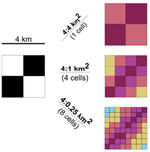Abstract
There is a lack of guidance on the choice of the spatial grain of predictor and response variables in species distribution models (SDM). This review summarizes the current state of the art with regard to the following points: (i) the effects of changing the resolution of predictor and response variables on model performance; (ii) the effect of conducting multi-grain versus single-grain analysis on model performance; and (iii) the role of land cover type and spatial autocorrelation in selecting the appropriate grain size.
In the reviewed literature, we found that coarsening the resolution of the response variable typically leads to declining model performance. Therefore, we recommend aiming for finer resolutions unless there is a reason to do otherwise (e.g. expert knowledge of the ecological scale). We also found that so far, the improvements in model performance reported for multi-grain models have been relatively low and that useful predictions can be generated even from single-scale models. In addition, the use of high-resolution predictors improves model performance; however, there is only limited evidence on whether this applies to models with coarser-resolution response variables (e.g. 100 km2 and coarser).
Low-resolution predictors are usually sufficient for species associated with fairly common environmental conditions but not for species associated with less common ones (e.g. common vs rare land cover category). This is because coarsening the resolution reduces variability within heterogeneous predictors and leads to underrepresentation of rare environments, which can lead to a decrease in model performance. Thus, assessing the spatial autocorrelation of the predictors at multiple grains can provide insights into the impacts of coarsening their resolution on model performance. Overall, we observed a lack of studies examining the simultaneous manipulation of the resolution of predictor and response variables. We stress the need to explicitly report the resolution of all predictor and response variables.
